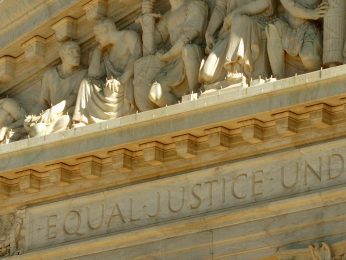The curricular materials posted here aim to teach about the U.S. Constitution “on the ground.” They highlight civil rights now, not historically, and civil rights struggle all around us—in our neighborhoods, school, workplaces—not just in Washington D.C.
The materials use a variety of instructional strategies—including trial and negotiation and debate role-plays—for teaching about modern civil rights. The materials presented have been developed by the Schoolhouse project of the University of Michigan Civil Rights Litigation Clearinghouse. Teachers from grades 8 through college can use the materials for lessons that localize constitutional law and practice, communicating to students that they and people like them are participants in developing and contesting civil rights norms.

Unit 1: Civil Rights Litigation: Purposes, Processes, and Promises
This unit introduces students to the concept of civil rights litigation. It asks students to consider how the litigation process reflects the fundamental values and principles of American constitutional government. By the end of this unit, students should be prepared to talk about how the civil litigation process reflects these values and principles and to describe civil rights litigation and its current scope.

Video: Introduction to Mock Trials
By participating in a mock trial, students will not only learn about the litigation process, but will also learn about how democratic values and principles can be applied to specific situations, why people disagree on when and how they should be applied, and how the courts are important in providing a forum for contestation and resolution of such disputes and in ensuring that our commonly held values and principles are protected.

Unit 2: Prisoners’ Rights Mock Trial
This unit asks students to consider civil rights inside the prison as they conduct a mock trial. By participating in a mock trial, students will not only learn about the litigation process, but will also learn about how democratic values and principles can be applied to specific situations, why people disagree on when and how they should be applied, and how the courts are important in providing a forum for contestation and resolution of such disputes and in ensuring that our commonly held values and principles are protected.

Unit 3: Title IX: Gender Equality in Public Education
Through most of U.S. history, women had limited access to educational programs and extracurricular activities. Most women were excluded from elite academic institutions, and those schools that accepted female applicants required them to have higher test scores and grades than their male counterparts. In the 1960s and 1970s, civil rights activists advocated for federal enforcement of equal opportunities for male and female students. In response, Congress enacted Title IX of the Education Amendments of 1972. This unit asks students to consider the scope and application of Title IX through the examination of statutory text, federal regulations, enforcement policies, and court decisions. Students are guided to confront questions about how the provisions of Title IX ensure nondiscrimination on the basis of gender, and to think about what sex equality means across different contexts.

Unit 4: Stop-and-Frisk: Fourth Amendment Violation or Necessary for Public Safety?
Some controversies arise when our shared values and principles conflict with one another. Police “stop-and-frisk” policy is one such issue. In stop-and-frisk, police officers stop, question, and conduct a pat-down search of pedestrians or occupants of cars. This unit will allow students the opportunity to explore and evaluate this issue through a variety of nonfiction sources, evaluating the strengths and weaknesses of the authors’ arguments. The focus of this unit is on the close reading of texts, and on building and supporting an argument.

Unit 5: Free Speech Rights in School
This unit asks students to consider the permissible restrictions schools can place on students’ freedom of speech, as they learn about the (fictional, but realistic) case of Davis v. Ann Arbor School Board. Students will either conduct a mock negotiation in which they will try to resolve a First Amendment-related conflict between a student and his public high school, or a mock argument in which they will argue for one side in front of a panel of student judges.

Unit 6: Religious Freedom Mock Trial
In this unit, students will participate in a mock trial that explores the rights and restrictions on individuals attempting to practice their own religion. Students will first familiarize themselves with the Religious Freedom and Restoration Act (“RFRA”), which was intended to further protect First Amendment rights. Students will then read and analyze case documents adapted from a real federal court case, Singh v. Carter, which involved a conflict between a soldier’s desire to exercise his religious practices and the U.S. Army’s interest in protecting its soldiers through uniform and safety requirements.

Additional Materials: Civil rights in a Trump Era teach-out
What does “civil rights” mean in the Trump era? How and why is the category evolving? This Teach-Out focuses on the civil rights aspects of two current debates–health care and the President’s seven-country travel ban–looking at politics, protest, and law. To understand these better, you will learn about foundational civil rights history dating back to Reconstruction (after the Civil War). You will also hear the perspectives of scholars in law, sociology, and political science, as well as civil rights advocates, who will all discuss how civil rights are defended and contested, often growing and contracting in response to other demands and debates. This Teach-Out ends with a call to action for you: How will you participate as our nation defines our rights?

